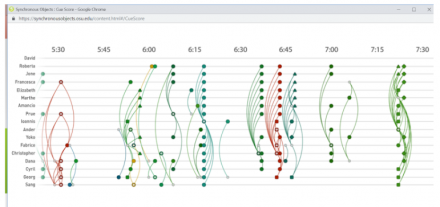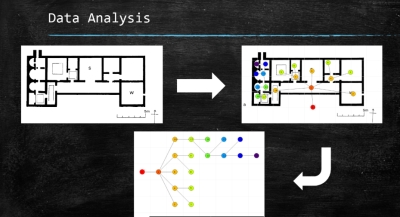DH Fellows: Matters Domestic, Theatrical, and Digital

Pictured: (left) Kelli Shermeyer displays an AR-produced dancing devil; (right) Sean Tennant presenting "Quantifying the Roman House"
DH Fellows: Matters Domestic, Theatrical, and Digital
Digital Humanities Fellows Kelli Shermeyer and Sean Tennant presented recent research in UVA’s Scholars’ Lab on May 1. Shermeyer, a former dramaturg, theater director, producer, and current doctoral student in the English department, began the proceedings with a presentation entitled, “Digital Skriker: New Directions for Archival Practices and Performance.” Sean Tennant, a doctoral student in the McIntire Department of Art, presented “Quantifying the Roman House,” in which Tenant used network analysis and quantitative methods to track ancient Roman cultural influences in northwest and northwestern Europe through shifts in domestic spatial arrangements.
In Shermeyer’s view, AR and VR technologies are put to best use when they are deployed in service of making storytelling more accessible, truthful, and resonant to audiences. Her analysis of motion capture technologies coincides with her aim to enhance storytelling and forge new ways of generating surprise, delight, and wonder for theater-goers. Without suggesting that large budgets and corporate backing are necessary, Shermeyer seeks to contest the notion that “theater is dying,” a notion which plays an outsize role in driving increased usage of AR and VR technologies in theatrical productions.

[Shermeyer's] analysis of motion capture technologies coincides with her aim to enhance storytelling and forge new ways of generating surprise, delight, and wonder for theater-goers.
Sean Tennant focused on two key questions in his research: 1) how to explain the leap from people living in round houses to Roman villas? and 2) how to glean patterns of ancient Roman cultural diffusion as it 
Tennant’s application of network analysis to architecture is relatively rare in the discipline of archaeology. Other methodologies he used like space syntax analysis are controversial among archaeologists who argue that it removes the human element from architectural analysis, but Tennant counters that ancient Roman textual sources offer intact, quantifiable data about the ways in which ancient Romans visualized and conceptualized their domestic spaces, enabling his DH approach to yield an important insight into the history of European homes. Tennant said he expected a sharper distinction between patterns of spatial arrangement in Roman Britain and Northwestern Europe but found that Roman Britain began adopting Roman patterns of living before Romans had ever arrived there.
